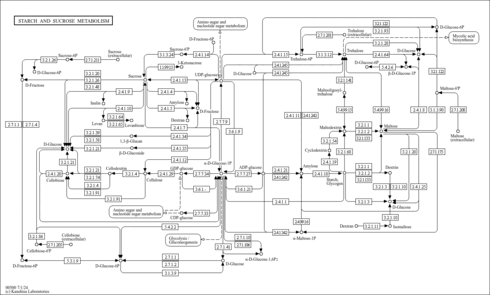| Identification |
|---|
| YMDB ID | YMDB01517 |
|---|
| Name | Chloride |
|---|
| Species | Saccharomyces cerevisiae |
|---|
| Strain | Brewer's yeast |
|---|
| Description | Chloride ion, also known as chloride(1-) or Cl, belongs to the class of inorganic compounds known as homogeneous halogens. These are inorganic non-metallic compounds in which the largest atom is a nobel gas. Chloride ion is an extremely strong acidic compound (based on its pKa). Chloride ion exists in all living species, ranging from bacteria to humans. Chloride ion is a potentially toxic compound. |
|---|
| Structure | |
|---|
| Synonyms | - Bertholite
- Chloride
- chloride ion
- Chloride(1-)
- chlorine
- Chlorine anion
- Chlorine, ion
- Cl
- Cl-
- Diatomic chlorine
- Dichlorine
- L-Methylmethionine sulfonium chloride
- Methylmethionine sulfonium chloride (JAN)
- molecular chlorine
- CL(-)
- Chloor
- Chlor
- Chlore
- Chlorine gas
- Cl2
- Chloride ion level
- Ion level, chloride
- Chlorides
- Level, chloride ion
- MSR-1 Protein, nicotiana plumbaginifolia
- PLS216 Protein, nicotiana plumbaginifolia
|
|---|
| CAS number | 16887-00-6 |
|---|
| Weight | Average: 35.453
Monoisotopic: 34.968852707 |
|---|
| InChI Key | VEXZGXHMUGYJMC-UHFFFAOYSA-M |
|---|
| InChI | InChI=1S/ClH/h1H/p-1 |
|---|
| IUPAC Name | chloride |
|---|
| Traditional IUPAC Name | chloride |
|---|
| Chemical Formula | Cl |
|---|
| SMILES | [Cl-] |
|---|
| Chemical Taxonomy |
|---|
| Description | belongs to the class of inorganic compounds known as homogeneous halogens. These are inorganic non-metallic compounds in which the largest atom is a nobel gas. |
|---|
| Kingdom | Inorganic compounds |
|---|
| Super Class | Homogeneous non-metal compounds |
|---|
| Class | Homogeneous halogens |
|---|
| Sub Class | Not Available |
|---|
| Direct Parent | Homogeneous halogens |
|---|
| Alternative Parents | Not Available |
|---|
| Substituents | |
|---|
| Molecular Framework | Not Available |
|---|
| External Descriptors | |
|---|
| Physical Properties |
|---|
| State | Gas |
|---|
| Charge | -1 |
|---|
| Melting point | -101 °C |
|---|
| Experimental Properties | | Property | Value | Reference |
|---|
| Water Solubility | Not Available | PhysProp | | LogP | Not Available | PhysProp |
|
|---|
| Predicted Properties | |
|---|
| Biological Properties |
|---|
| Cellular Locations | Not Available |
|---|
| Organoleptic Properties | Not Available |
|---|
| SMPDB Pathways | |
|---|
| KEGG Pathways | | Starch and sucrose metabolism | ec00500 |  |
|
|---|
| SMPDB Reactions | Not Available |
|---|
| KEGG Reactions | Not Available |
|---|
| Concentrations |
|---|
| Intracellular Concentrations | | Intracellular Concentration | Substrate | Growth Conditions | Strain | Citation |
|---|
| 16020 ± 19 µM | 100mM CsCl in 45mM Tris-sucinate buffer pH 4.5, 50g/L glucose | aerobic | Brewer's yeast | PMID: 777014 | | 11748 ± 19 µM | 100mM RbCl in 45mM Tris-sucinate buffer pH 4.5, 50g/L glucose | aerobic | Brewer's yeast | PMID: 777014 | | Conversion Details Here |
|
|---|
| Extracellular Concentrations | Not Available |
|---|
| Spectra |
|---|
| Spectra | | Spectrum Type | Description | Splash Key | View |
|---|
| LC-MS/MS | LC-MS/MS Spectrum - 40V, Positive | splash10-00di-0009000000-6fb9c471131023c432df | JSpectraViewer | MoNA | | LC-MS/MS | LC-MS/MS Spectrum - 30V, Positive | splash10-00di-0009000000-81a678b03172c0d73abf | JSpectraViewer | MoNA | | LC-MS/MS | LC-MS/MS Spectrum - 10V, Positive | splash10-00di-0009000000-5df8560ed945712b8481 | JSpectraViewer | MoNA | | LC-MS/MS | LC-MS/MS Spectrum - 20V, Positive | splash10-00di-0009000000-80bd16051562ea5ee2b7 | JSpectraViewer | MoNA | | LC-MS/MS | LC-MS/MS Spectrum - 50V, Positive | splash10-0a4i-0009000000-cf0884f0a8324da15f74 | JSpectraViewer | MoNA | | Predicted LC-MS/MS | Predicted LC-MS/MS Spectrum - 10V, Positive | splash10-000i-9000000000-c4fb3d037fe2e74c2a5e | JSpectraViewer | | Predicted LC-MS/MS | Predicted LC-MS/MS Spectrum - 20V, Positive | splash10-000i-9000000000-c4fb3d037fe2e74c2a5e | JSpectraViewer | | Predicted LC-MS/MS | Predicted LC-MS/MS Spectrum - 40V, Positive | splash10-000i-9000000000-c4fb3d037fe2e74c2a5e | JSpectraViewer | | Predicted LC-MS/MS | Predicted LC-MS/MS Spectrum - 10V, Negative | splash10-001i-9000000000-d488e6da5c7ecb77869a | JSpectraViewer | | Predicted LC-MS/MS | Predicted LC-MS/MS Spectrum - 20V, Negative | splash10-001i-9000000000-d488e6da5c7ecb77869a | JSpectraViewer | | Predicted LC-MS/MS | Predicted LC-MS/MS Spectrum - 40V, Negative | splash10-001i-9000000000-d488e6da5c7ecb77869a | JSpectraViewer | | Predicted LC-MS/MS | Predicted LC-MS/MS Spectrum - 10V, Negative | splash10-001i-9000000000-c2fa753da65a4bac80a1 | JSpectraViewer | | Predicted LC-MS/MS | Predicted LC-MS/MS Spectrum - 20V, Negative | splash10-001i-9000000000-c2fa753da65a4bac80a1 | JSpectraViewer | | Predicted LC-MS/MS | Predicted LC-MS/MS Spectrum - 40V, Negative | splash10-001i-9000000000-c2fa753da65a4bac80a1 | JSpectraViewer |
|
|---|
| References |
|---|
| References: | - Roomans, G. M., Seveus, L. A. (1976). "Subcellular localization of diffusible ions in the yeast Saccharomyces cerevisiae: quantitative microprobe analysis of thin freeze-dried sections." J Cell Sci 21:119-127.777014
|
|---|
| Synthesis Reference: | Weber, Rainer; Bulan, Andreas; Haas, Michel; Warsitz, Rafael; Werner, Knud. Production of chlorine from hydrogen chloride and oxygen. PCT Int. Appl. (2007), 30pp. CODEN: PIXXD2 WO 2007134861 A1 20071129 CAN 148:35931 AN 2007:1361621 |
|---|
| External Links: | |
|---|

